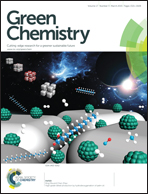Yield optimization and rational function modelling of enzymatic hydrolysis of wheat straw pretreated by NaOH-delignification, autohydrolysis and their combination†
Abstract
A thorough efficacy assessment was performed on three wheat straw saccharification processes including NaOH-delignification, autohydrolysis and their combination, with subsequent enzymatic hydrolysis. Instead of optimizing the process for maximal sugar yield from straw, a novel perspective is provided, allowing optimization of the overall yield against enzyme consumption and reaction volume. At total sugar yields above 60%, NaOH-delignification was the most efficient in terms of enzymatic and volumetric productivity, whereas at lower yields, autohydrolysis showed a comparable enzymatic and a higher volumetric productivity. The double treatment led to improved hydrolysability compared to autohydrolysis, but was the least productive due to reduced solid yields. A threshold in the delignification efficiency between 3% and 6% NaOH-loadings per straw DM resulted from the depletion of alkalinity by the released organic acids. A novel rational function model was developed for the total sugar yield, which is generally superior for describing asymptotic behaviour compared to conventional polynomial models in response surface modelling.


 Please wait while we load your content...
Please wait while we load your content...